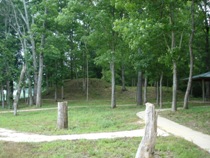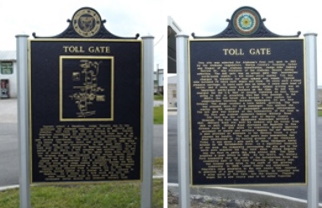

Hamilton is situated almost in the center of Marion County. The roots of the county go back to the early history of the State of Alabama. Marion County takes its name from the Revolutionary War Hero Frances Marion, and was created as the largest Alabama territorial county in 1818. At this time the county stretched deep into what is now South Alabama and Mississippi. Settlers from Tennessee, Kentucky, Georgia, and the Carolinas came here to settle what was then known as the Mid-Western Frontier. Hamilton, in its early history was first known as Toll Gate, named for a toll-gate on the old Military Road.
Hamilton spans the historic passage known as "Military Road", which was carved out of the wilderness by volunteer soldiers from Tennessee returning North to their homes from victory over the British at New Orleans in 1815. The army of General Andrew Jackson - who ordered the development of the road as a short cut between New Orleans and Nashville - camped at Military Ford, three miles south of Hamilton, as they ventured homeward. A bike and hiking trail is underway to commemorate the time-honored road's turn in United States history.
The Pikeville area - located just south of Hamilton - served as the county seat for several years until Captain A.J. Hamilton offered to donate 40 acres of his land in Toll Gate to the community. In 1883, the Toll Gate donation from Capt. Hamilton was accepted following referendum, and the name of the community was officially changed to Hamilton in his honor. His family home and grave-site is still preserved today.
From a few dozen families and settlers in the 1880's, Hamilton grew rapidly. The first school was established in 1884, and in 1891 evolved into a high school.

Indian history and roots are also deeply established here as well. The Chickasaw Tribe hunted here and provided corn to the newly arrived immigrants. One of the upcoming restorative efforts that the City of Hamilton has underway is to re-establish the presence of the Indian burial grounds and mounds that still remain within Hamilton along the banks of the Buttahatchee River.
One of our community's most notable figures was Hamilton native Rankin Fite, a son of a State Legislator. Rankin Fite, following in his father's footsteps, was a major figure in Alabama politics as well and served in both the House and the Senate. He eventually became a powerful Speaker of the House, leading many advances in the city, such as the county's 7,000 foot airport and a technical school which is today part of Bevill State Community College.
The University of Alabama hosts an aerial photo archive. Here is a link to the Marion County, Alabama section of the archive.
Marion County Historical Aerial PhotosIn 1821 the Alabama Legislature selected this site for Alabama's first toll gate. Judge John Dabney Terrell Sr. (Marion County's founding father and framer of the Alabama constitution), was the President of the Alabama Senate during selection. Toll Gate was a gate that intersected north/south traffic. A toll was charged to help maintain the road. Tolls included: 75 cents for each wagon and team, 50 cents for each 2-wheel pleasure carriage, 12 cents for each man on horse, 4 cents for each head of cattle, and 2 cents for each hog or sheep. There was no charge for the U.S. Mail, people traveling on foot, and for those going to mill or preaching. The toll house became a rest station for the stagecoaches that where traveling between Washington, DC and New Orleans. The stage sounded a horn for each passenger before arriving to let the station know how many passengers where needing refreshment. The toll gate was located at the intersection of the road to Gin Port (original seat of Marion County) and Andrew Jackson's famous Military Road. In 1821 Gin Port became Mississippi territory. Military Road (build by Jackson and his troops from 1816 to 1821) shortened the route from Nashville to New Orleans by 200 miles. This road made the movement of supply and artillery wagons easier for our military. Military Road was also an alternate route to Natchez Trace which was plagued by bandits. The intersection (constructed on the hunting grounds of the Chickasaw Tribe) was about 1 mile north of three Chickasaw burial mounds on the Buttahatchee River.

The name "Toll Gate" was given to the community surrounding the site and to the north as a significant landmark to the area. The first to settle this area was a man named William Ragsdale around 1818. A post office was put in Toll Gate in 1838. Just south of the Buttahatchee River is the Military Ford Community which by the 1840's was part of Toll Gate. About seven miles south of this community was Pikeville (the county seat). Lamar County was established in 1868. Since Pikeville was so close to the new county line there was a new county seat selected. An unsettled area (called Center) 6 miles north of Toll Gate won the election.
The Alabama Legislature was petitioned for a new county seat election by Captain Albert J. Hamilton (Judge Terrell's son-in-law). In 1881 Toll Gate won the site election. Captain Hamilton donated 40 acres of his land in Toll Gate to the Community to be sold in lots. The money from the lots was to be used to construct a new county courthouse. In his honor the new town was named "Hamilton". The town was still under construction in 1882 when the county court was moved there. The Toll Gate post office was also moved to Hamilton and renamed that same year. A toll complex which was about three miles north of the original site had become the new seat of county government over a period of 60 years.
Judge Terrell's final resting place is in the Chickasaw burial mounds. He played an important role in establishing the toll gate. Before becoming demolished in the 1970's the toll house and the stage station became the Bolin House. One partially burned timber (rescued from a cleanup fire in 1974) is on display at the Nix Library in Hamilton.